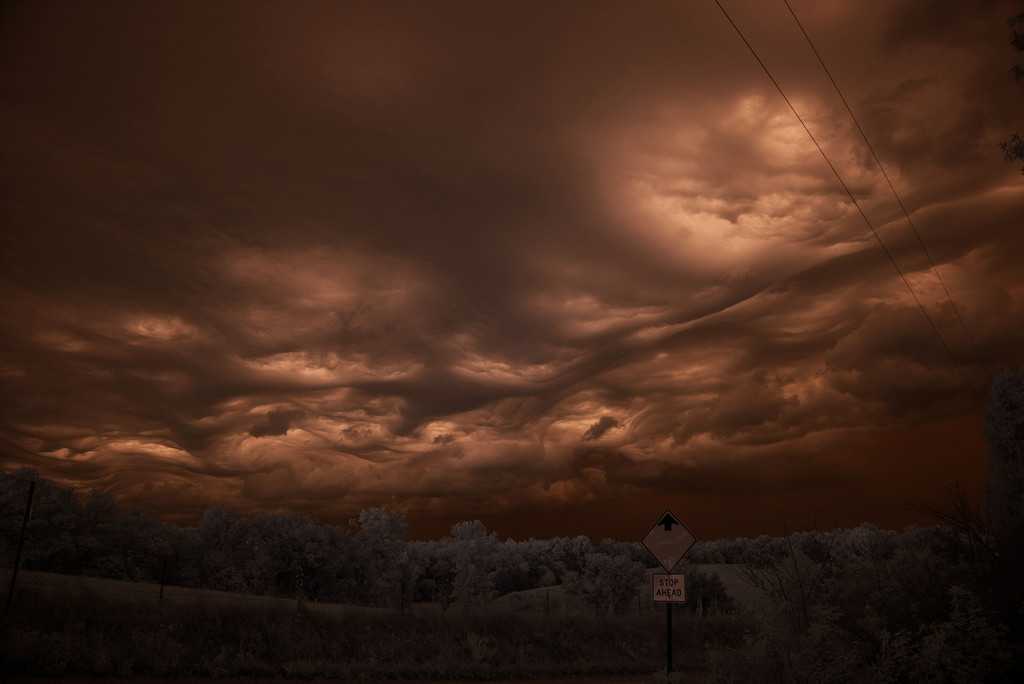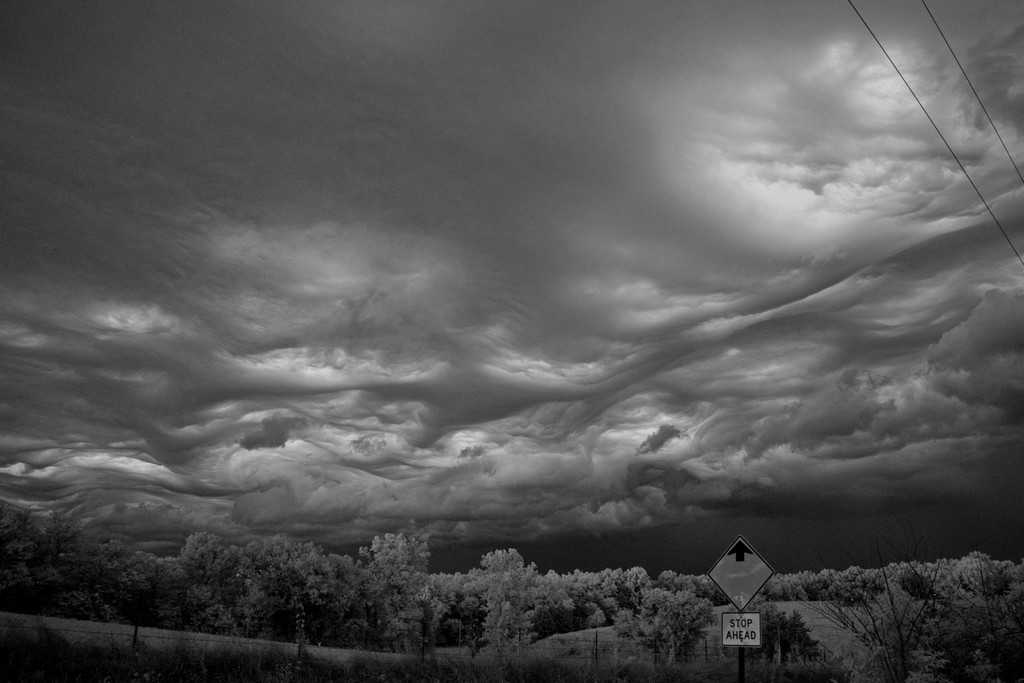Writhing Cloud Phenomena
Forums › Cloud Identification Help › Writhing Cloud Phenomena
Tagged: Asperitas
- This topic has 5 replies, 4 voices, and was last updated 5 years, 2 months ago by
 George Preoteasa.
George Preoteasa.
-
AuthorPosts
-
-
September 4, 2020 at 6:43 pm #445825
 Dave LochhaasParticipant
Dave LochhaasParticipantIn early July I experienced a writhing cloud formation that seemed unreal and yet I watched it for 25 minutes and could hear the farm hands on the next hill shouting about it, “Look at that! Look at that!” The time of day was 18:24 CDT and the location was central Missouri, USA.
(I shoot clouds with an infrared converted camera, meaning the camera’s sensor has a filter that blocks visible light and only allows infrared light to pass. I like the way cloud form is enriched although the color is false, mapped by the camera sensor’s response to the invisible IR light.)
This cloud formation was in constant motion as it slowly drifted east northeast and I was rocked by wind gusts from every direction at ground level. The camera is aimed at the southeast sky. The dark line of thunderstorms in the background was moving east. There were occasional distant lightning strikes in this dark line with little or no thunder, I’m guessing about 30 miles distant to the south. About 45 minutes later a wider front 0f very active thunderstorms came through overhead from the west.
The first image is made from the 32 MB RAW file. This is as the camera saw it and as I saw it through the viewfinder of a mirrorless camera. The only processing was to convert the image to a 1024 x 684, 100 KB, JPEG photo. I’ve included this to show how I got to the next image of the same photo.
To help eliminate confusion from the infrared photography, particularly from the false color, I converted the RAW image to monotone by desaturating the color and increasing the brightness, trying my best to present an image that can be evaluated and explained. I also processed the image to a 1024 x 684, 100 KB, JPEG photo for viewing in this forum.
I need help with what’s going on in my photo and what the name is of this cloud formation. Thanks.


-
September 6, 2020 at 4:33 pm #445966
 Daniel MehtaParticipant
Daniel MehtaParticipantHi, Dave!
This is a fine example of the supplementary feature cloud known as asperitas: the cloud which Gavin Pretor-Pinney of this very society named!
I’m not entirely sure what the mechanisms behind the flowing waves (Gavin will hopefully post his hypothesis/hypotheses here); however, one thing is for certain: atmospheric instability is needed for these clouds to form in the wavy manner that they do… This explains why you saw them accompanying nearby thunderstorms!
Check out this utterly amazing time-lapse showing the fluid dynamics of asperitas in action!
As a side note, the main cloud genus is, IMO, Altocumulus, the species of which is stratiformis and the variety opacus – so, altogether, the cloud is Altocumulus stratiformis opacus asperitas. If anybody thinks differently (perhaps the genus is Stratocumulus), please let me know. :D
Great photographs, though. You’re very lucky to have seen such a stunning display of asperitas, especially one associated with nearby thunderstorm activity. Next time you see them, try to take a time-lapse; I’m sure your awe would be accentuated *even more*. :)
Dan
-
September 7, 2020 at 4:12 pm #446043
 Gavin Pretor-PinneyKeymaster
Gavin Pretor-PinneyKeymasterThanks for this question, Dave. And for your fine answer, Dan!
It is indeed an example of asperitas. The formation mechanism is never too clear, but one hypothesis is that the chaotic wave features in the vicinity of a storm are to do with gravity waves that are trapped between inversion layers.
Those are great shots!
-
September 12, 2020 at 4:50 pm #446641
 George PreoteasaParticipant
George PreoteasaParticipantDave, fantastic photos! I can only wish I can catch a situation like this.
I wanted to ask you about your camera. I just sent one for IR conversion. I am doing it for astrophotography, but I was considering cloud photography at some point (maybe after another conversion, possibly full removal of the filter). So I am curios what kind of conversion did your camera undergo. What kind of filter do you have now, if any, what range of the spectrum does it allow and how does that work for cloud photography?
This link shows the range of the h-alpha filter I am getting, all the way at the bottom.
I would appreciate your comments. Thank you.
-
September 16, 2020 at 4:18 pm #446946
 Dave LochhaasParticipant
Dave LochhaasParticipantHi George, Here’s a quick reply to your questions. I have a Canon DSLR converted by lifepixel.com with their standard IR filter, equivalent to 720 nm. Six months ago I got a mirrorless Fujifilm camera converted by lifepixel.com to the enhanced IR filter, equivalent to 665 nm. This filter slightly overlaps visible light in the deep red frequencies. It does allow for a greater range of color when I manipulate the false color with RGB channel mixing (using Affinity Photo software). Both cameras provide wonderful photos of clouds illuminated by IR light.
For a variety of reasons I only shoot the mirrorless Fujifilm camera now. I do like the enhanced color of the 665 nm filter because I tremendously enjoy experimenting with the false color the camera’s sensor produces ( https://www.flickr.com/photos/davelochhaas ).
This has gotten off-thread. I would love to discuss cloud photography techniques and equipment. Let’s move this discussion to an appropriate forum of which I cannot seem to locate. Maybe it is time to start one if there is enough interest.
-
September 18, 2020 at 4:13 am #447046
 George PreoteasaParticipant
George PreoteasaParticipantThanks for the info, Dave. I like the false colors, though not sure how much post-processing work they required.
I like the idea of a an IR cloud photos thread, but I don’t have much to contribute. You, however, based on what I see on Flicker, may have quite a few to share. I will certainly watch the thread.
One cheap (or fake) way to pretend shooting in IR is to use a deep red filter with the camera in b/w mode. I have one of those, so maybe I’ll try some imitation IR.
-
-
AuthorPosts
- You must be logged in to reply to this topic.




